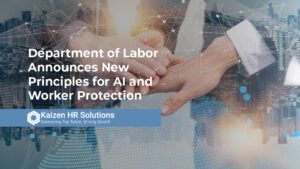Quiet quitting. What began as a viral video has become one of the most talked about (and written about) topics this year. Is it a valid phenomenon, or is it nothing more than catchy clickbait? To a certain degree, the answer to that question does not matter. Rather than debating the significance of the symptoms, this is an opportunity for leaders to proactively address the more important matter: the cause.
While many organizations excel in the areas of employee engagement and retention, the tenor in the marketplace (and perhaps why the original video gained so much traction) is that this is the exception – not the rule. The symptoms indicate that something has shifted; the cause of that shift deserves a discussion. For HR, the phenomenon needs to be viewed from both sides: developing a strategy to combat “quiet quitting” throughout the organization, while ensuring that HR employees aren’t the ones “quietly quitting” themselves.
What’s New?
In the video – which has over 3.5 million views – 24-year-old TikToker Zaid Khan (@zaidlepplin) states that “work is not your life.” This is not a new concept. But assuming that work is a requisite part of life, to view the act of employment simply as a means to an end overlooks the opportunity that purposeful, gratifying, challenging work can provide.
When given a choice to do the bare minimum necessary to stay employed, or proactively constructing a professional environment that provides meaning, which would most choose? The latter is the obvious choice, but is easier said than done. And although the need for professional fulfillment is nothing new, the external factors have changed:
- The pandemic shifted people’s attitudes toward work, creating a time of reflection during which some reassessed the importance of things in their lives beyond work.
- Remote and hybrid work environments have created employees who feel disconnected from their work, workplace, and coworkers. HR employees may feel a particular disconnect: their jobs are about the “human” side
- Lack of boundaries between work and personal life have created, for some, an “always working” dynamic that leads to burnout.
- New career and early career employees have never “gone to work” and thus have a weaker personal investment or commitment to an organization, its people, or its mission.
- Lack of organizational focus/attention necessary to keep employees aligned, motivated and moving forward in their organizations and in their careers. “Out of sight, out of mind” is not an effective formula for employee engagement and retention.
Understanding the Underlying Cause
“What is your why?” It sounds like an esoteric question, but why is it that you choose to go to work each day? Why do you choose this profession, instead of something else? Why do you choose the role you are in, as opposed to others?
Encourage yourself and others to press beyond the obvious answer of “I need to make money.” There are countless ways to earn a living; why have you chosen this one?
Incorporate The Five Whys, which originated within the Toyota Production System and are an integral part of Lean Manufacturing, Kaizen, and Six Sigma. Taiichi Ohno saw the Five Whys as an especially important part of Toyota’s overall philosophy. The process is simple: Just ask why five times in succession to get to the true root cause of the problem. This is a remarkably simple process, but more often than not, we stop at the very first “why” and try to do something about the symptoms rather than getting to the true root causes.
Once you begin to list all of your whys, you will notice they fall in two categories. The first category is similar to Maslow’s lowest hierarchy of needs – food, water, shelter. “I’d like to be able to pay my mortgage.” “I want to send my children to college.” “My elderly parents will rely on me to provide for them.” “I have always dreamed of buying a vacation home.”
The second category recognizes that there is a bigger purpose, a desire to make a difference, and a need to higher meaning behind the choices we make. Both categories are important and not mutually exclusive. An individual who only cares about money will likely live with a void in their life, while an individual who is all about the big picture has their head in the clouds but lacks feet on the ground.
What Comes Next?
- Acknowledge this is a leadership issue. In his book Extreme Ownership, former Navy Seal Jocko Willink writes: “On any team, in any organization, all responsibility for success and failure rests with the leader. The leader is truly and ultimately responsible for everything.” HR leadership must address manager engagement first, then re-skill them to be successful in a hybrid/remote working world – and this includes the HR team itself.
- Rebuild the psychological contract with employees. The 20th Century psychological contract was transactional: Employees showed up every day from 9-5, and in return were rewarded with a paycheck and a pension. The 21st Century contract is relational. Employees want a paycheck, but they want challenge, career growth, support, and meaningful relationships. More than ever, leaders must build (rebuild) trusting relationships with their employees. When people feel valued, they are more likely to naturally engage or reengage in their work.
- Commit to Offer High-Quality Work. High-quality work means having varied and meaningful tasks, clear goals, and a positive team climate. Particularly relevant today, high-quality work also means having reasonable demands and expectations of workers. Leaders need to be especially careful about not overwhelming people with excessive demands, long work hours, or unreasonable pressures. HR can model this kind of positive, healthy, and balanced approach to work, providing a blueprint for the rest of the organization.
- Acknowledge and Respect that Employees Have Changed. Quiet quitting is an identity shift. See employees as they are now vs. who they were pre-pandemic. Employees want autonomy over their work, not just in how they carry out their tasks, but also — as much as possible — influence over where and when they work.
- Work to Reconnect Employees/Teammates. Employee engagement relies on feeling connected to one another individually and connected as at team to a bigger purpose. Leaders must be intentional in creating interaction and cohesion. HR should be working with the organization’s overall leadership to develop the support systems necessary for hybrid and remote work to truly be a success.
Quiet quitting isn’t new. It’s a new twist on an old problem. But it has captured people’s attention. As leaders, it’s on us to address it.







